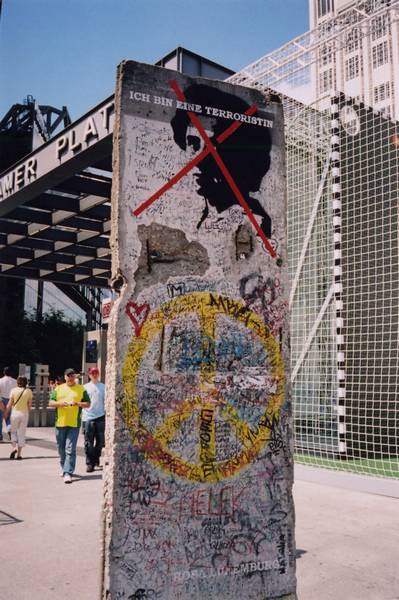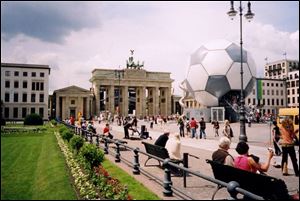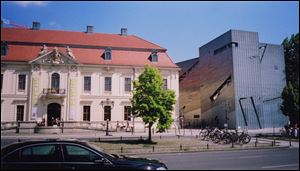
History meets hip in Berlin
7/30/2006
Pieces of the Berlin Wall remain in Berlin, painted with colorful graffiti and political statements. A block-long section stands across from the Berlin Wall Documentation Center.

A building-size soccer ball - part of the hubbub surrounding the recently completed World Cup competition - flanks Berlin's famous Brandenberg Gate, a momument to peace where Ronald Regan implored the Soviet Union's Mikhail Gorbachev to 'tear down this wall.'
BERLIN - Berlin is a city that cannot escape its past.
You notice it everywhere:
In the Kaiser Wilhelm Memorial Church, whose splintered steeple cuts through the city's skyline, left unrepaired as a reminder of the devastating bombing of World War II.
In the tourists who buy chunks of the Berlin Wall and sport T-shirts saying, "You are now entering the American sector."
Even in the recently completed World Cup. At least one London airport put up a sign reminding travelers headed to Germany that it's illegal to have Nazi paraphernalia there, and even provided a box in which to dump such items before getting on the plane.
It's been more than 60 years since the fall of the Third Reich and more than 15 since the Berlin Wall crumbled. A lot has changed since then. The city has become famous for its hip, vibrant lifestyle, its wild nightlife, and, of course, German beer. But the city's DNA still shows scars.
Berlin does not have the elegant, ancient look of some European cities. That's in part because the sprawling city - eight times the size of Paris - had to be rebuilt after the Allies reduced large parts of it to rubble.
In some ways, it all traces back to the Reichstag, the seat of the German parliament which greets the nation with the words, "To the German people," written across the brow of its grand columned entrance.
A suspicious fire there that the Nazis blamed on the communists is what helped Hitler's party consolidate power. Today, visitors can peer out over the city from the glass dome on its roof, home to a giant solar cone that powers the building.
Nearby is the famous Brandenburg Gate, a majestic monument to peace that became best known for its role in the Cold War. Poised along the border of East and West Germany, this is where Ronald Reagan asked Mikhail Gorbachev to "tear down this wall."
Now, it is the most obvious symbol of a united city, and its Room of Silence offers visitors a chance to reflect - or just catch their breath before heading down the Unter den Linden, a cool stretch of shops and restaurants that used to be known as the "idiot's mile" because it's all visitors often saw of the unimpressive East.

Pieces of the Berlin Wall remain in Berlin, painted with colorful graffiti and political statements. A block-long section stands across from the Berlin Wall Documentation Center.
The days of communist oppression continue to occupy a prime spot in the city's psyche - and not just the kitschy shops selling little bits of the Berlin Wall to tourists.
At one point, the wall stretched more than 100 miles and divided more than East from West; it separated family, sweethearts, and friends. As it was being built, some escaped to freedom by jumping from windows of buildings along the border until even those were sealed.
Most of the wall is gone now. While some remains are painted with colorful graffiti and political statements, a full block stands across from the Berlin Wall Documentation Center as an inauspicious reminder of the past.
It's not as imposing or menacing as you might imagine. The barbed wire is gone; the machine guns are gone; the guards ordered to fire upon their own people are gone. All that's left are two concrete barriers separated by an open field known as the death strip.
The wall's true impact is more evident at the Checkpoint Charlie museum, located at the famous border crossing point between the American and Soviet sectors. Every corner and scrap of wall space is crammed with information, pictures, and artifacts.
It's a testament to human ingenuity, showing how people escaped using fake American uniforms, secret compartments in cars, everything except a lawn chair with helium balloons tied to it.
A personal favorite was the story of a group of senior citizens who dug a tunnel just to spite their neighbor who rebuffed their help in digging his own tunnel. Other oddities include a stuffed badger that was shot by the head of the Stasi, the East German secret police. (Not sure why that was there. Same with the candle in the shape of Stalin's head.)

The Jewish Museum's gleaming new wing, right, contrasts sharply with the old building.
At its heart, Berlin is a city of museums, from fine art to ancient history. The Pergamon Museum is one of the most magnificent, named for the town in modern-day Turkey whose Pergamon Altar is partially recreated inside. Coming face to face with the altar - reproduced to scale, complete with a frieze of amazing, life-size sculptures depicting Greek gods in battles - is jaw dropping. You can actually climb the steps just as worshippers did thousands of years ago.
Other finds in the museum include the Ishtar Gate, the mammoth entrance to Babylon, and remnants of other ancient cultures that were dismantled by German archaeologists and reconstructed here.
Even here the country's wartime history asserts itself when you see a Roman market gate from Miletus. It's massive - and under repair, damaged during World War II and repaired incorrectly at the time.
Fast forward to modern times and there's the shimmering new wing of the Jewish museum, designed by Daniel Libeskind like a lightning bolt striking through the heart of the city and its past.
No two walls are parallel, and the architecture makes you lose your bearings. It traces the history of the Jewish people from their first settlements in Germany and early persecutions to the tough question of how life could go on after the Holocaust, when the number of Jews in Berlin had fallen from 160,000 to a mere 7,000.
Back outside, the city's expansiveness - and its beer halls - are best experienced on foot. But its great system of trains and subways makes it easy to escape to the beautiful suburbs.
Even outside the city, the reflections of history are apparent.
Quaint little Lehde, with seemingly as many canals as footpaths, is home to the country's only indigenous ethnic minority, the Sorbs. They were one of the groups nearly wiped out by the Nazis.
Today, the town an hour away from Berlin is known for being in the midst of a picturesque forest, where the Spree River spreads its fingers through the countryside and begs to be seen by boat or kayak. The village's thatched roofs and mounded haystacks are an idyllic reminder of a fading way of life.
In Potsdam, there's still the stigma of being the town where the Allies gathered to carve up Germany after World War II. But it's also home to the gorgeous palaces and gardens of the Kaisers.
Its Park Sanssouci is a paradise of flowers and greenery, palaces and nymph statues, and - surprisingly - a giant windmill. The 600 acres of visual riches are a must-see.
It is here, somewhere between the gurgling fountains and the warbling birds, one can finally feel outside of time and find ... peace.
Contact Ryan E. Smith at: ryansmith@theblade.com or 419-724-6103.